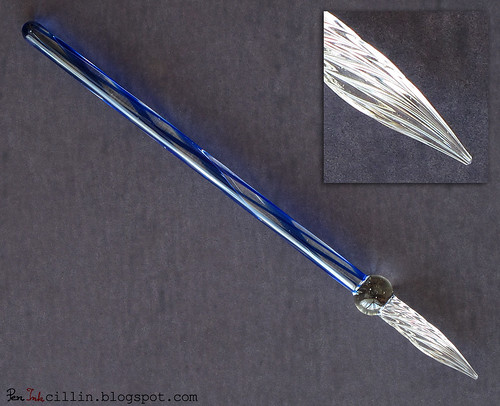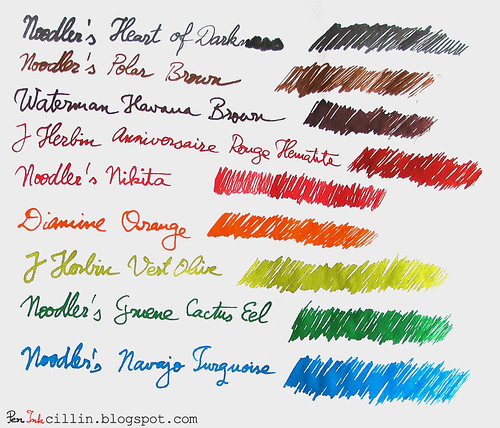This particular J Herbin glass dip pen is part of the largest pen and ink order I placed over a year ago. I haven't reviewed it until now because I've had more important things to review. It turns out that there isn't much to say about a dip pen, especially one as simple as this.
There were two J Herbin glass pens for sale when I bought mine. There's a more elaborate one (which looks more fragile) and then there's this one. I opted for the simpler (and cheaper) one because I was more interested in the functionality than the aesthetics.
At $15.75 this pen isn't exactly cheap (considering that actual fountain pens can be bought for this amount) but on the other hand these pens are supposed to be hand-crafted so I guess that's where the bulk of the cost is. The more intricate pens are more expensive, at $20+.
The J Herbin dip pen is crafted from a solid glass rod with a colored spiral pattern surrounding it. This rod is on the thin side, about as thick as your average pencil. I can't say that it makes for comfortable lengthy writing. The rod (or body of the pen) ends in a transparent glass ball which, I assume, is there to help you grip the pen and also to prevent ink from getting on your fingers. Moving on, we have the tip, which is also glass, twisted tightly to form a series of spiral grooves.
The grooves serve a simple purpose: they trap the ink between them so that you don't have to dip the pen after every word, essentially acting as a reservoir. Thanks to this simple design, you should be able to write a whole line or two before re-dipping.
The tip itself is quite broad, if you will forgive the use of the term. It is not very precise and if you look at it closely you'll see that it resembles a cone, meaning that it is uniform on all sides. This is, perhaps, one of the reasons why this pen doesn't write very well. The other reason is that the part of the tip which touches the paper isn't smooth. Instead, it is rough.
The pen does write, as you can see from the sample below. However, you need to be careful how much ink you "load" on the tip, or else you'll end up with it pooling on the paper, as is the case with the last 3 letters of the word "Darkness". The very nature of the dip pen causes text to be uneven: it starts out thick and saturated and it slowly thins out and fades away as the ink is depleted.
Thanks to the rough tip, the pen feels raspy on paper. Is this design intentional? If you have any information regarding this I'd be happy to hear about it. The roughness doesn't bother me a lot because I'm aware I'm not using a fountain pen with a metal nib.
J Herbin's glass dip pen feels a lot like a novelty pen to me. It is pretty but there are dip pens which cost much less and write a lot better. I have found a good use for this pen. Virtually all my ink reviews have a small sentence written with this pen. The writing itself is ugly (because the pen distorts my already-messy script) but the point is to show the ink's saturation and shading (if available). There's another advantage to a glass dip pen: it cleans incredibly easy. You can use any type of ink on it (even Baystate Blue!) and it will never remain stained. It's glass, after all, and glass is inert in contact with inks.
Would I recommend it? Not really. I find it too expensive for its limited utility. But don't let that stop you from buying it if you are so inclined!
The inks used in the sample are all the bottles I own (alas, only 9 of them) and I have reviewed all of them in the past:
Noodler's Heart of Darkness
Noodler's Polar Brown
Waterman Havana Brown
J Herbin 1670 Anniversaire
Noodler's Nikita
Diamine Orange
J Herbin Vert Olive
Noodler's Gruene Cactus Eel
Noodler's Navajo Turquoise



Nice review. I have a glass pen and don't really enjoy using it that much. I thought I'd use it to write short samples of ink colors but don't even find it practical for that. They are pretty to look at though. ;-)
ReplyDeleteI bought the same dip pen about 8 months ago with every intention of writing ink samples and such... I got the same result as you: it's pretty and I guess it works if you like being extra fancy, but that's just about it.
ReplyDeleteThanks! I don't have anything else to write quick samples with so at least I'm getting some use out of it. I just hope I don't break it.
ReplyDeleteI think a much better dip pen would be a nib holder with a set of Brause (or equivalent) nibs. And one of those sets is cheaper than the glass pen.
ReplyDeleteI think the scratchiness is an issue with the J Herbin ones. The Goulets were having quality control issues with the ones they got, and if I remember right have decided to stop selling them. I'm planning on buying one of the really pretty R&K ones because my J Herbin glass pen is terribly scratchy and only writes if held one certain way...
ReplyDeleteThe Goulets are still selling both versions of the JH. The R&Ks are mighty expensive but maybe they do write better. If you get one, drop me a line, let me know how it is.
ReplyDeleteGood review! I have the same pen, and have found the same issues -- scratchiness and writable at one spot only. I did some smoothing with sandpaper to reduce the scratch, but it wasn't fully successful. I do use this pen fairly regularly to test out ink samples and such. The ease of cleanup is really its only saving grace.
ReplyDeleteThanks, looks like we both got the exact same impressions. Oh well, live and learn!
ReplyDeleteGlass dip pens can be scratchy if the tips are not formed or finished properly. You can try to fix this by "smoothing" the writing tip (I would not call it a "nib").
ReplyDeleteTry a "nail buffer" you can likely find one at any drug store. These are softish nail polishing strips with foam-like backing. Typically the buffers will have four surfaces going from coarser to finer polishing grit. The finest grit surface should feel very smooth, not like sand-paper at all.
Dip the pen in ink (important, don't do this on a dry tip or nib). Then start with the coarse or medium coarse grit. Slowly work to form and polish the tip of the pen. Then move progressively to the finer grits while polishing the tip. Go slowly testing the pen as you go (remember to clean the tip before dipping into the ink bottle again - or you may contaminate your ink).
On a traditional fountain pen nib, once you have checked for tine alignment, this polishing technique can also be used to smooth your nib.
Professionals will follow the nail buffer treatment with one or two final polishes on sheets of Mylar micro-mesh polishing film.
A cloth polishing wheel on a rotary tool with some polishing rouge can work also, but be careful, don't get too aggressive and polish the tip off.
Remember you are removing material from the tip, this is a "one-way trip" kind of process.
Thanks for the review - David
Excellent tip, thank you David. I knew about this but it was somewhere at the edges of my memory, thanks for reminding me. When I get the time I'll see if I can steal a nail buffer from my wife :)
ReplyDeleteI got a pen much like this one for my birthday a while back. I have two, one that looks like the one you have presented here and one that looks fairly the same but the rod is twisted in the same way the tip is. It does seem like the ball between the tip and the rod is to provide a stable grip and to keep the ink from getting all over your fingers, but I've found it also gives a good stand for the pen when I need a moment and sits just at the edge of the ink bottles the pens came with.
ReplyDeleteThank you David for that idea with the tips of the pens, I noticed mine are kind of scratchy, although I'm not certain if they were supposed to be made like this or not.
I'm attempting to learn how to write evenly with the pens so I can write letters with the pens and ink and so far all I really have to comment on it is that if your not careful about how much ink you load on the tip at first that it can blot randomly and that if you are continuously spinning the pen(like, after every word spinning it about a fifth of the way around) then you can go even longer without having to redip.
I use the spinning method too. I'm terrible at using this pen though. The only writing I do with it is for my ink tests, because it makes it easy to dip it quick, write something and then wash it.
ReplyDelete